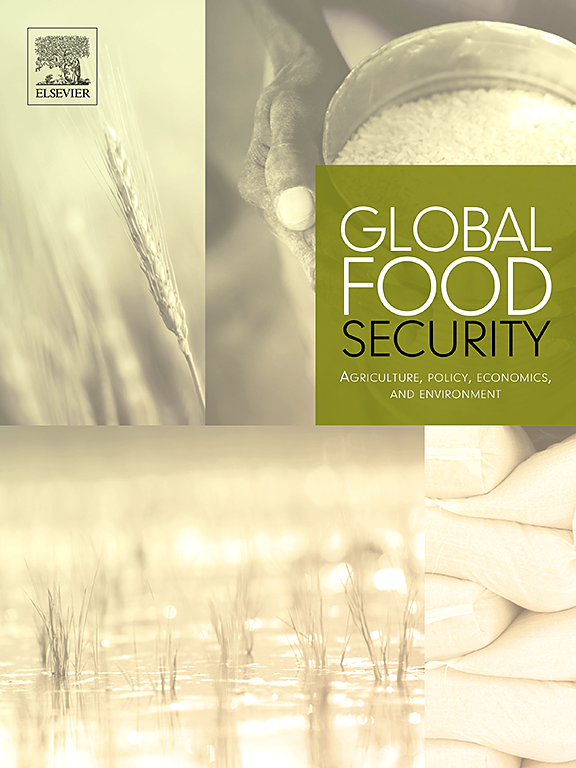It's time to consider global catastrophic food failures
IF 9.6
1区 经济学
Q1 FOOD SCIENCE & TECHNOLOGY
Global Food Security-Agriculture Policy Economics and Environment
Pub Date : 2025-08-21
DOI:10.1016/j.gfs.2025.100880
引用次数: 0
Abstract
Food systems today face interconnected, systemic risks that could culminate in widespread disruptions triggering extreme global famine, in addition to neglected extreme risks. This paper introduces the concept of Global Catastrophic Food Failure (GCFF) to describe such scenarios; where food shortages overwhelm response capacities of governments and private sectors, necessitating extraordinary interventions. A GCFF could be triggered by various mechanisms including: abrupt sunlight reduction scenarios from a volcanic winter (like a Tambora-scale eruption), nuclear winter, or asteroid impact that could cause near-total agricultural collapse; multiple breadbasket failures from synchronous extreme weather events causing >10 % yield losses; collapse of critical climate systems like the Atlantic Meridional Overturning Circulation (AMOC) that could eliminate half of wheat and maize cultivation zones; or cascading disruptions to global trade and agricultural inputs (fertilizers, fuel, machinery) that could reduce crop production by up to 40 % across staples. These events would be characterized by rapid onset, extended duration over multiple years, extreme magnitude affecting global food supply by 5–10 % or more, and limited resilience exceeding normal coping mechanisms. While the exact likelihood of certain GCFF scenarios is uncertain, forecasts over the century indicate a probability of over 10 % for each of: a large climate-changing eruption, a nuclear war, and an AMOC collapse. Currently, GCFF is a blind spot requiring research and policy efforts to strengthen food systems' resilience and capacity to sustain humanity.
是时候考虑全球灾难性的粮食短缺了
今天的粮食系统面临着相互关联的系统性风险,除了被忽视的极端风险外,这些风险可能最终导致广泛的破坏,引发全球极端饥荒。本文引入了全球灾难性粮食衰竭(GCFF)的概念来描述这种情况;粮食短缺超出了政府和私营部门的应对能力,需要采取非常干预措施。GCFF可能由多种机制触发,包括:火山冬季(如坦博拉火山规模的喷发)、核冬季或小行星撞击造成的突然日照减少情景,可能导致几乎全部农业崩溃;同时发生的极端天气事件导致多个粮仓发生故障,造成10%的产量损失;大西洋经向翻转环流(AMOC)等关键气候系统的崩溃,可能会使一半的小麦和玉米种植区消失;或者对全球贸易和农业投入(化肥、燃料、机械)的连锁破坏,可能使主要作物的产量减少多达40%。这些事件的特点是发生迅速,持续时间长达数年,对全球粮食供应的极端影响为5 - 10%或更多,恢复能力有限,超出正常应对机制。虽然某些GCFF情景的确切可能性尚不确定,但本世纪的预测表明,每种情景发生的可能性都超过10%:气候变化的大型火山喷发、核战争和AMOC崩溃。目前,GCFF是一个盲点,需要通过研究和政策努力来加强粮食系统的抵御力和维持人类生存的能力。
本文章由计算机程序翻译,如有差异,请以英文原文为准。
求助全文
约1分钟内获得全文
求助全文
来源期刊

Global Food Security-Agriculture Policy Economics and Environment
FOOD SCIENCE & TECHNOLOGY-
CiteScore
20.90
自引率
3.40%
发文量
69
期刊介绍:
Global Food Security plays a vital role in addressing food security challenges from local to global levels. To secure food systems, it emphasizes multifaceted actions considering technological, biophysical, institutional, economic, social, and political factors. The goal is to foster food systems that meet nutritional needs, preserve the environment, support livelihoods, tackle climate change, and diminish inequalities. This journal serves as a platform for researchers, policymakers, and practitioners to access and engage with recent, diverse research and perspectives on achieving sustainable food security globally. It aspires to be an internationally recognized resource presenting cutting-edge insights in an accessible manner to a broad audience.
 求助内容:
求助内容: 应助结果提醒方式:
应助结果提醒方式:


